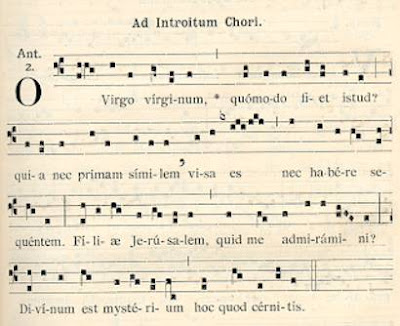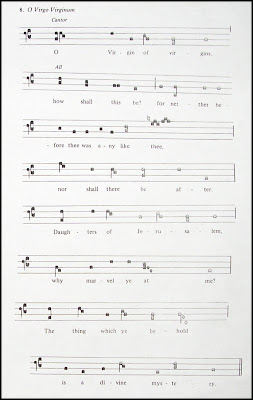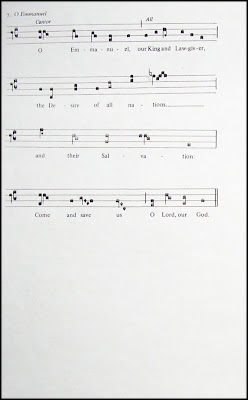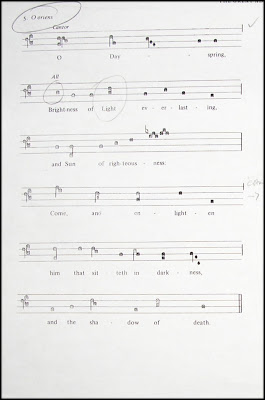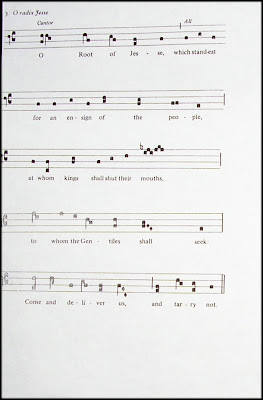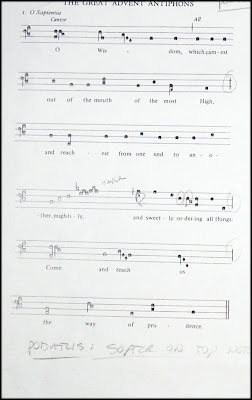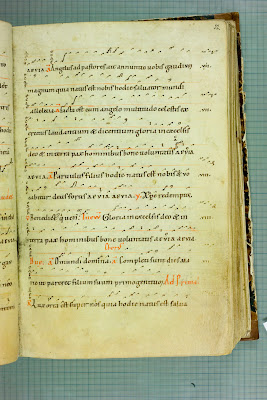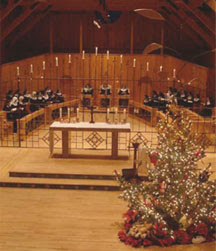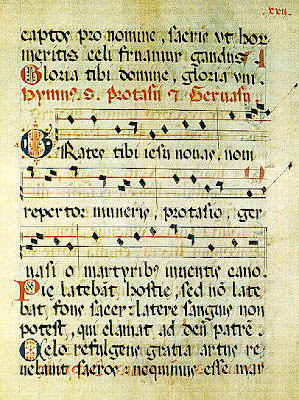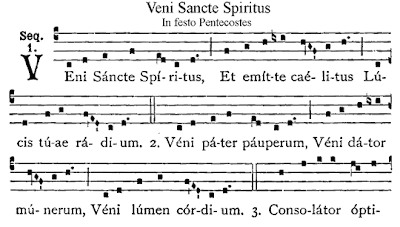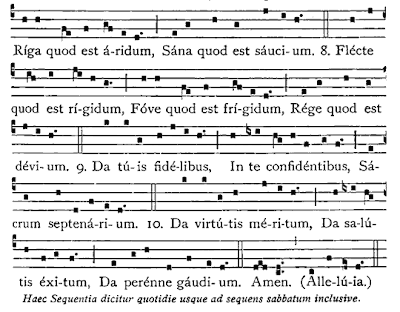Yesterday at the church of St. Mary the Virgin, part of the mass was taken from the "Worcester Fragments":
Here's an idea of how this music sounds; this was recorded live at a Medieval Music festival in Sweden:
Here's the content from the YouTube page:
This video is labeled "Cadfael - Sanctus And Benedictus (from the Worcester fragments)"; I'm not sure exactly what that means. Perhaps they used a recording of this during one of the TV shows? In any case, I don't know who the singers are.
More examples: here's an mp3 sample of a piece entitled "Beata Víscera," from the website of the Introitus Ensemble.
Here's an mp3 of "Salve Sancta Parens."
There is also an entire page of samples at this page, a CD put out by the Orlando Consort, consisting entirely of pieces from the Worcester Fragments; the Sanctus is there, and it's quite beautiful. And here is a CD offered at Amazon.com: "Alleluia Nativitas: Medieval Christmas," where you will find some of the same pieces; many of them are apparently specifically for singing at Christmastide.
Here's a page at Oxford with photos of "15 original leaves of 'The Worcester Fragments' (from manuscripts of polyphonic music, in Latin), recovered from late-medieval bindings of Worcester Cathedral Priory, now at the Bodleian. England, Worcester; Late 13th - early 14th cent."
I believe I am allowed under the terms of their copyright policy to point to images on their server (although I am not allowed to download and post them myself). So I will do that. Here is an image labeled "ol. 12r (formerly 11r, and LXXXIIIr in the medieval foliation) (a) 'Amor patris presentatur' (Mot) (b) 'Munda Maria mater militie' (Mot)":

Here's one labeled "fol. 16v (formerly 15v) 'Kyrie fons pietatis' (Tr or Mot only)":

I don't think there are any of the three pieces sung yesterday online, but reference is made at the site to other fragments.
Here's the Wikipedia page about this:
Here's a page at "Findarticles" called "The cohesion of the Worcester fragments".
A bit outside the topic of "chant," but interesting and worth posting, I thought.
The setting of Sanctus, Benedictus and Agnus Dei comes from the Worcester fragments. Dating from the late thirteenth century and early fourteenth century, the fragments are among the most priceless pieces of late medieval English polyphony.
Here's an idea of how this music sounds; this was recorded live at a Medieval Music festival in Sweden:
Here's the content from the YouTube page:
Nomemus - Nordic festival for Medieval Music, 2011, Söderköping Sweden.
Extract from concert with Trio Mediaeval ensemble in S:t Laurentii church, 8 September 2011. Music from the Worcester Fragments of 13th -- 14th century England
The concert was called: A Worcester Ladymass.
Singers: Anna Maria Friman , Linn Andrea Fuglseth, Torunn Östrem Ossum
www.nomemus.se
This video is labeled "Cadfael - Sanctus And Benedictus (from the Worcester fragments)"; I'm not sure exactly what that means. Perhaps they used a recording of this during one of the TV shows? In any case, I don't know who the singers are.
Cadfael - Sanctus And Benedictus (from the Worcester fragments) sur WAT.tv sélectionnée dans Musique
More examples: here's an mp3 sample of a piece entitled "Beata Víscera," from the website of the Introitus Ensemble.
Here's an mp3 of "Salve Sancta Parens."
There is also an entire page of samples at this page, a CD put out by the Orlando Consort, consisting entirely of pieces from the Worcester Fragments; the Sanctus is there, and it's quite beautiful. And here is a CD offered at Amazon.com: "Alleluia Nativitas: Medieval Christmas," where you will find some of the same pieces; many of them are apparently specifically for singing at Christmastide.
Here's a page at Oxford with photos of "15 original leaves of 'The Worcester Fragments' (from manuscripts of polyphonic music, in Latin), recovered from late-medieval bindings of Worcester Cathedral Priory, now at the Bodleian. England, Worcester; Late 13th - early 14th cent."
I believe I am allowed under the terms of their copyright policy to point to images on their server (although I am not allowed to download and post them myself). So I will do that. Here is an image labeled "ol. 12r (formerly 11r, and LXXXIIIr in the medieval foliation) (a) 'Amor patris presentatur' (Mot) (b) 'Munda Maria mater militie' (Mot)":

Here's one labeled "fol. 16v (formerly 15v) 'Kyrie fons pietatis' (Tr or Mot only)":

I don't think there are any of the three pieces sung yesterday online, but reference is made at the site to other fragments.
Here's the Wikipedia page about this:
The Worcester Fragments are a collection of medieval music associated with the English town of Worcester.
The Worcester Fragments comprise 25 short pieces of vocal music. They are referred to as "fragments" because they do not exist in one unified manuscript but have been reassembled from sheets used as book-binding material in later centuries. These old materials had themselves at some stage been bundled together into several collections of flyleaves and saved in various books which had historical connections with Worcester. Once it was recognised that these scattered fragments came from the same source it was possible to piece them together, though much remained missing.
The pieces are from the 13th century. None of them is longer than 5 minutes, some as little as 1 minute long. They demonstrate a variety of musical forms from the period, including the conductus and motet.
Here's a page at "Findarticles" called "The cohesion of the Worcester fragments".
A bit outside the topic of "chant," but interesting and worth posting, I thought.


